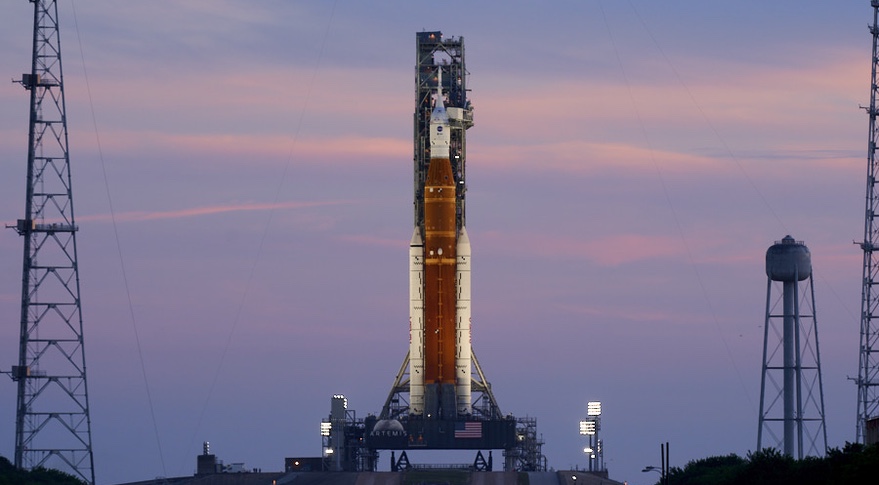
Updated Oct. 19 to change number of SLS launches included in the contract.
WASHINGTON — A procurement document sheds new light on the formation of a joint venture to which NASA plans to award a long-term contract for producing the Space Launch System rocket.
NASA published Oct. 12 a document formally known as the Justification for Other Than Full and Open Competition for its planned Exploration Production and Operations Contract (EPOC) for as many as 10 SLS launches. The document explains NASA’s rationale, announced July 26 in a pre-solicitation statement, to sole-source the EPOC contract rather than hold a competition.
That contract would be sole-sourced to Deep Space Transport (DST), a joint venture of Boeing and Northrop Grumman whose existence had not been publicized by the companies or NASA prior to the release of the pre-solicitation statement. Boeing is currently the prime contractor for the SLS core stage and the Exploration Upper Stage that will be used on the Block 1B version of SLS, while Northrop Grumman is the prime contractor for the SLS’s five-segment solid rocket boosters.
According to the justification document, predating Deep Space Transport was Project Eta, a team that included Boeing, Northrop, Aerojet Rocketdyne and other companies. Project Eta was one of four entities to respond to a request for information (RFI) NASA issued in October 2021 regarding the proposed EPOC contract. Project Eta “provided a thorough response proposing the formulation of a JV [joint venture] to meet the launch service needs of EPOC,” NASA stated.
The Project Eta response emphasized the importance of a “single accountable customer interface” for the contract as well as 17 unspecified “Affordability Efficiency Initiatives” that would provide cost savings. While NASA has not set a formal cost for EPOC, agency officials previously discussed a per-flight cost reduction of 50% or more.
Three other organizations also responded to the RFI: All Points, Barrios Technology and SAIC. None of them, though, proposed taking on the EPOC contract, instead commenting on various aspects of the RFI.
NASA said it examined other launch contracts it had, along with those by the U.S. Space Force, noting that none of them “include the requirement to lift 42t [metric tons] in a single-launch to the Moon and beyond,” which is the projected SLS Block 1B payload capacity. The agency concluded the RFI responses and research “yielded no knowledge of feasible alternatives for launch services using existing SLS hardware and validated NASA’s planned sole source approach.”
At some point before the release of the pre-solicitation statement, “Project Eta was informed a formal corporate structure would be necessary to move forward with the procurement process,” the NASA document noted, not disclosing who specifically informed the team of that requirement. “Deep Space Transport, a joint venture between Boeing and Northrop Grumman, was formed to replace Project Eta.”
The NASA document notes elsewhere that DST was established on June 6. A company with the same name was incorporated in the state of Delaware the same day, according to state databases. While DST is a joint venture of Boeing and Northrop, NASA states it is “strategically aligned” with Aerojet Rocketdyne, which provides the RS-25 engines used in the core stage of the SLS and the RL10 engines in the Exploration Upper Stage.
NASA added it received one response, whose identity is redacted in the justification document, to its pre-solicitation statement. “Analysis of this submission yielded no additional information or capabilities which would change NASA’s intent to award a sole source contract for the EPOC requirements to DST,” it stated.
Much of the document explained NASA’s rationale with working with Boeing, Northrop and Aerojet on EPOC, citing their extensive work on the SLS and access to infrastructure that could, the agency argued, take up to a decade to replicate by another company. Because of that, NASA concluded, “DST is the only responsible source to provide launch services under EPOC using the SLS Vehicle, and no other services will satisfy NASA’s requirements.”
NASA added in the justification statement that it will look for “alternative solutions or new sources” before exercising any options on the EPOC contract, which as currently proposed would cover the Artemis 5 through 9 missions with options for Artemis 10 through 14. NASA, in the pre-solicitation statement in July, said that the contract would also include an option for up to 10 non-Artemis SLS missions, but NASA spokesperson Rachel Kraft said Oct. 19 that the agency had “refined our planning” and would limit EPOC to the 10 Artemis missions listed in the justification statement.
Related
ncG1vNJzZmiroJawprrEsKpnm5%2BifK%2Bt0ppkqK2kobavsdJmmpqrlWKzsL6MppikoZ6cerS7y55krKelp7CmedKlqmaZp5a%2FpXnTqGSbp5Weu6h5zaipraCipL1uts6ipa1lppq7tcHRnmY%3D